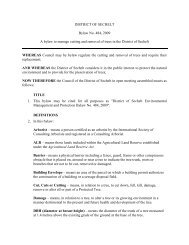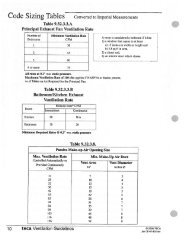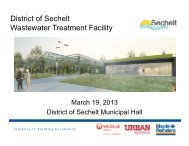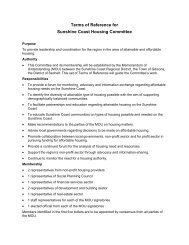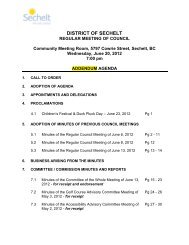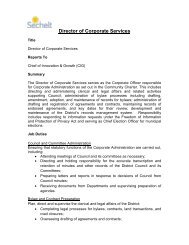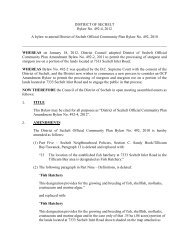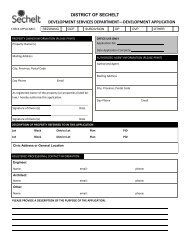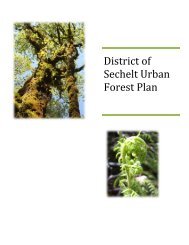DPA 5 Steep Slopes - District of Sechelt
DPA 5 Steep Slopes - District of Sechelt
DPA 5 Steep Slopes - District of Sechelt
You also want an ePaper? Increase the reach of your titles
YUMPU automatically turns print PDFs into web optimized ePapers that Google loves.
Alternative road and pedestrian<br />
designs may be needed in steep<br />
areas. Meandering sidewalks or paths<br />
may be used where they eliminate<br />
steep grades or protect natural site<br />
features. Varying <strong>of</strong>fsets between the<br />
road and sidewalk may be<br />
considered.<br />
(a) Identify and protect natural<br />
drainage flows.<br />
(b) Maintain predevelopment<br />
hydrology through site design,<br />
building and landscape design<br />
techniques that infiltrate, filter,<br />
store, evaporate and detain<br />
stormwater close to its source;<br />
(c) Provide stormwater recharge<br />
areas and maximize onsite<br />
groundwater recharge in stable<br />
areas. This may include<br />
retention or detention ponds,<br />
constructed wetlands, sand<br />
filters, parking areas designed<br />
with bioretention features,<br />
infiltration ditches to return<br />
stormwater to water table.<br />
(d) Minimize impervious surfaces to<br />
reduce stormwater run<strong>of</strong>f and to<br />
prevent excessive run<strong>of</strong>f and<br />
erosion.<br />
(e) Limiting vegetation clearing and<br />
soil disturbance;<br />
(f) Use existing or new vegetation to<br />
slow run<strong>of</strong>f and help stormwater<br />
infiltrate the soil (i.e. filter strips<br />
and grass swales);<br />
(g) Divert downspouts away from<br />
driveway surfaces and into<br />
retention areas/rain gardens or<br />
rain barrels/dry wells to capture,<br />
store and infiltrate stormwater<br />
on-site.<br />
(h) Assess and mitigate any<br />
potential drainage impacts on<br />
downhill properties.<br />
(i) Provide sediment and erosion<br />
control during and after<br />
construction until final<br />
revegetation on all lots is<br />
established.<br />
Parks and Trails<br />
47. Small pocket parks with viewpoints<br />
and trail connections may be the<br />
preferred form or park development<br />
in hillside areas where conventional,<br />
flat parkland is not available.<br />
48. Development applications must<br />
provide details <strong>of</strong> pedestrian access<br />
through the area. Trails or linear<br />
greenways may be used where site<br />
constraints limit the viability <strong>of</strong><br />
conventional sidewalks or shared<br />
roadway pedestrian use.<br />
Fire Hazard<br />
Preserve natural drainage courses to reduce stormwater flows<br />
49. Subdivisions directly adjacent to<br />
forested areas may be required to<br />
prepare a fire interface hazard<br />
assessment. Recommendations <strong>of</strong><br />
that plan may be incorporated into<br />
the development permit, including<br />
fire resistant building materials,<br />
removal <strong>of</strong> risky vegetation/fuel,<br />
replanting with appropriate<br />
vegetation and building sprinklers.<br />
<strong>District</strong> <strong>of</strong> <strong>Sechelt</strong> Bylaw 492, 2010 Environmental and Natural Hazard <strong>DPA</strong> Guidelines 162<br />
Official Community Plan





